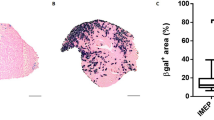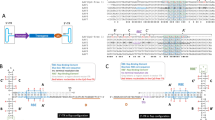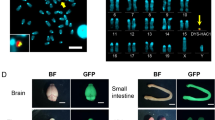Abstract
Gene transfer by direct intramuscular injection of naked plasmid DNA has been shown to be a safe, simple but relatively inefficient method for gene delivery in vivo. Eukaryotic plasmid expression vectors incorporating the Epstein–Barr virus (EBV) origin of replication (oriP) and EBNA1 gene have been shown to act as autonomous episomally replicating gene transfer vectors which additionally provide nuclear matrix retention functions. Prolonged expression of a LacZ reporter gene and recombinant human dystrophin was shown using EBV-based plasmid vectors transfected into C2C12 mouse myoblast and myotube cultures. Intramuscular injection of EBV-based dystrophin expression plasmids into nude/mdx mice resulted in significant enhancement in the number of muscle fibres expressing recombinant dystrophin compared with a conventional vector. This effect was observed for over 10 weeks after a single administration. These results indicate the potential advantage of EBV-based expression vectors for focal plasmid-mediated gene augmentation therapy in Duchenne muscular dystrophy (DMD) and a range of other gene therapeutic applications.
This is a preview of subscription content, access via your institution
Access options
Subscribe to this journal
Receive 12 print issues and online access
$259.00 per year
only $21.58 per issue
Buy this article
- Purchase on Springer Link
- Instant access to full article PDF
Prices may be subject to local taxes which are calculated during checkout


Similar content being viewed by others
References
Emery AEH . Duchenne Muscular Dystrophy, 2nd edn Oxford Medical Publications: Oxford 1993
Brown SC, Dickson G . Duchenne Muscular Dystrophy. In: Dickson G (ed) Molecular and Cell Biology of Human Gene Therapeutics Chapman & Hall: London 1995 pp 261–280
Acsadi G et al. Human dystrophin expression in mdx mice after intra-muscular injection of DNA constructs Nature 1991 352: 815–818
Acsadi G et al. Dystrophin expression in muscles of mdx mice after adenovirus-mediated in vivo gene transfer Hum Gene Ther 1995 1: 129–140
Dickson G . Gene therapy for Duchenne muscular dystrophy Chem Indust 1997 8: 294–297
Dickson G et al. Human dystrophin gene transfer: production and expression of a functional recombinant DNA-based gene Hum Genet 1991 88: 53–58
Decrouy A et al. Mini-dystrophin gene transfer in mdx4cv diaphragm muscle fibers increases sarcolemmal stability GeneTherapy 1997 4: 401–408
Decrouy A et al. Mini- and full-length dystrophin gene transfer induces the recovery of nitric oxide synthase at the sarcolemma of mdx4cv skeletal muscle fibers Gene Therapy 1998 5: 59–64
Phelps SF et al. Prevention of muscular dystrophy by full-length and internally truncated dystrophins Hum Mol Genet 1995 4: 1251–1258
Wells DJ et al. Expression of human full-length and minidystrophin in transgenic mdx mice: implications for gene therapy of Duchenne muscular dystrophy Hum Mol Genet 1995 4: 1245–1250
Dunckley MG, Wells DJ, Walsh FS, Dickson G . Direct retroviral-mediated transfer of a dystrophin minigene into mdx mouse muscle in vivo Hum Mol Genet 1993 2: 717–723
Fassati A et al. Genetic correction of dystrophin deficiency and skeletal muscle remodelling in adult mdx mouse via transplantation of retroviral producer cells J Clin Invest 1997 100: 620–628
Vincent N et al. Long-term correction of mouse dystrophic degeneration by adenovirus-mediated transfer of a minidystrophin gene Nat Genet 1993 5: 130–134
Dodds E et al. Lipofection of cultured mouse muscle cells: a direct comparison of Lipofectamine and DOSPER Gene Therapy 1998 5: 542–551
Trivedi R, Dickson G . Liposome-mediated gene transfer into normal and dystrophin-deficient mouse myoblasts J Neurochem 1995 64: 2230–2238
Yanagihara I, Inui K, Dickson G, Okada S . Expression of full-length human dystrophin cDNA in MDX mouse by HVJ-liposome injection Gene Therapy 1996 3: 549–553
Dickson G . Gene transfer to muscle Biochem Soc Trans 1996 24: 514–519
Wells KE et al. Immune responses, not promoter inactivation, are responsible for decreased long-term expression following plasmid gene transfer into skeletal muscle FEBS Lett 1997 407: 164–168
Wells DJ et al. Evaluation of plasmid DNA for in vivo gene therapy: factors affecting the number of transfected fibers J Pharm Sci 1998 87: 763–768
Margolskee RF . Epstein–Barr virus expression vectors CurrTopics Microbiol Immunol 1992 158: 67–95
Yates JL, Guan N . Epstein–Barr virus-derived plasmids replicate only once per cell cycle and are not amplified after entry into cells J Virol 1991 65: 483–488
Krysan PJ, Haase SB, Calos MP . Isolation of human sequences that replicate autonomously in human cells Mol Cell Biol 1989 9: 1026–1033
Jankelevich S, Kolman JL, Bodnar JW, Miller G . A nuclear matrix attachment region organizes the Epstein–Barr viral plasmid in Raji cells into a single DNA domain EMBO J 1992 11: 1165–1176
Mellon P, Parker R, Gluzman Y, Maniatis T . Identification of DNA sequences required for transcription of the human α-1-globin gene in a new SV40 host-vector system Cell 1981 27: 279–288
Queen C, Baltimore D . Immunogloblin gene-transcription is activated by downstream sequence elements Cell 1983 33: 341–348
Mecsas J, Sugden B . Replication of plasmids derived from bovine papilloma virus type 1 and Epstein–Barr virus in cells in culture Ann Rev Cell Biol 1987 3: 87–108
Dyrks T et al. Generation of bA4 from the amyloid protein precursor and fragments thereof FEBS Lett 1993 335: 89–93
Whitesell L, Rosolen A, Neckers LM . Episome-generated N-myc antisense RNA restricts the differentiation potential of primitive neuroectodermal cell lines Mol Cell Biol 1991 11: 1360–1371
Pan LC, Margolskee RF, Blau HM . Cloning muscle isoforms of neural cell adhesion molecule using an episomal shuttle vector Somat Cell Mol Genet 1992 18: 163–177
Deiss LP, Kimchi A . A genetic tool used to identify thioredoxin as a mediator of growth inhibitory signal Science 1991 252: 117–120
Trojan J et al. Loss of tumorigenicity of rat glioblastoma directed by episome-based antisense cDNA transcription of insulin-like growth factor 1 Proc Natl Acad Sci USA 1992 89: 4874–4878
Lindenboim L, Anderson D, Stein R . The use of Epstein–Barr virus-based shuttle vectors in rat PC12 cells Cell Mol Neurobiol 1997 17: 119–127
Krysan PJ, Calos MP . Epstein–Barr virus-based vectors that replicate in rodent cells Gene 1993 136: 137–143
Wohlgemuth JG et al. Long-term expression from autonomously replicating vectors in mammalian cells Gene Therapy 1996 3: 503–512
Belharz MW et al. Quantitation of muscle precurser cell activity in skeletal muscle by northern blot analysis of MyoD andmyogenin expression: application to dystrophic (mdx) mousemuscle Mol Cell Neurosci 1992 3: 326–331
DiMario JX, Uzman A, Strohman RC . Fiber regeneration is not persistent in dystrophic (mdx) mouse skeletal muscle Dev Biol 1991 48: 314–321
Yaffe D, Saxel O . Serial passaging and differentiation of myogenic cells isolated from dystrophic mouse muscle Nature 1997 270: 725–727
Sherratt TG, Vulliamy T, Strong PN . Evolutionary conservation of the dystrophin central rod domain Biochem J 1992 287: 755–759
Acknowledgements
This work was supported by the UK Medical Research Council, the Leopold Muller Trust and the Muscular Dystrophy Group of Great Britain and Northern Ireland.
Author information
Authors and Affiliations
Rights and permissions
About this article
Cite this article
Tsukamoto, H., Wells, D., Brown, S. et al. Enhanced expression of recombinant dystrophin following intramuscular injection of Epstein–Barr virus (EBV)-based mini-chromosome vectors in mdx mice. Gene Ther 6, 1331–1335 (1999). https://doi.org/10.1038/sj.gt.3300944
Received:
Accepted:
Published:
Issue Date:
DOI: https://doi.org/10.1038/sj.gt.3300944
Keywords
This article is cited by
-
Easy stable transfection of a human cancer cell line by electrogene transfer with an Epstein–Barr virus-based plasmid vector
Medical Molecular Morphology (2007)
-
Non-viral gene delivery in skeletal muscle: a protein factory
Gene Therapy (2003)
-
Prolonged gene expression in mouse lung endothelial cells following transfection with Epstein–Barr virus-based episomal plasmid
Gene Therapy (2003)
-
LCR-mediated, long-term tissue-specific gene expression within replicating episomal plasmid and cosmid vectors
Gene Therapy (2002)
-
Establishment of an oriP/EBNA1-based episomal vector transcribing human genomic β-globin in cultured murine fibroblasts
Gene Therapy (2002)



